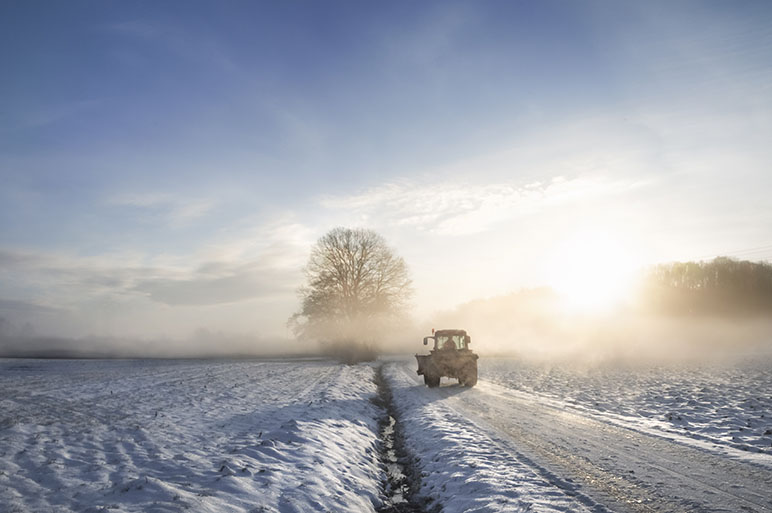
As fall turns to winter, the combines that have harvested the crops are tucked away in barns and the vast fields are empty until spring. But are they really empty? If you look across Indiana, you may not find the brown of plowed fields or harvested crops, instead you may find fields of green. That green field is the newest crop and tool that farmers are using today to help protect the environment and be more sustainable--cover crops.
What is a cover crop?
Cover crops are plants that are grown typically after the main crop is harvested. Cover crops are non-cash crops, meaning the plants are grown and not harvested, or if the crops are harvested, they are not sold but used on the farm, perhaps as livestock feed. The list of common types of cover crops grown in Indiana includes rye, winter wheat, buckwheat, clovers, winter peas and radishes.
What is a cover crop used for?
If cover crops are not harvested and sold, why would a farmer bother to plant them in their fields? Farmers reap many non-monetary benefits from cover crops.
Conservation and sustainability of the soil
Farmers reap the benefits from the numerous advantages of growing cover crops. Many of these benefits improve the health of the farm, the environment and the sustainability of farming for future generations.
One of the largest benefits of a cover crop is the reduction of soil erosion. Roots from the cover crops hold the valuable topsoil in place to help prevent it from being blown away by wind and running downstream from rain and snow.
Another benefit is the improvement of the soil’s health by providing additional organic matter to soil. Increased organic matter in the soil leads to healthier soil by aiding the soil structure, water-holding capacity, nutrient holding capacity and increases biological activity. Specific types of cover crops, such as radishes, can be used to break up compacted soil. By breaking up the soil, it allows for more water to be absorbed and held in the soil, which reduces the effects of both flooding and drought.
The addition of cover crops to the crop rotation also helps to control pests and disease and smothers weeds. Rotating crops helps break the cycles of many types of pests and disease. Also, continuously having a growing crop planted helps smother out weeds and affords the primary crop a better start. Using cover crops in this way allows farmers to use less pesticides and weed control the following year.
Cover crops improve biodiversity on the farm. They provide winter food for wildlife, as well as cover and habitats that bare soil does not offer. Studies have found that cover crops increase the number of earthworms which is also beneficial for soil health.
Cover crops can contribute to the fertility of the soil by helping the soil retain valuable nutrients from fertilizers, so they are available for next year’s crop. They also add nutrients to the soil. Legumes, such as clovers and peas, increase the nutrients in the soil and reduce the amount of fertilizer the farmer needs to apply next year.
Finally, cover crops help mitigate climate change; they are an important part of carbon sequestration (the process of capturing and storing atmospheric carbon dioxide) on the farm. Having a crop grow year-round increases the amount of carbon that can be absorbed and placed back in the soil. The roots and plants of cover crops provide an inviting environment for bacteria, fungi, earthworms and other soil organisms, which increases soil carbon levels over time.
Since cover crops are not considered cash crops, they are not eligible for crop insurance coverage. In the 2018 Farm Bill, the use of cover crops was considered a “good farming practice.” This further confirmed that cover crops are a useful tool for farms and that the growing of cover crops will not affect a farmer’s crop insurance.
Are you in need of crop insurance or farm insurance? Indiana Farm Bureau Insurance is the number one farm insurance writer in Indiana and is here for all of your insurance needs. Request a free quote online to get the process started and protect your farm and crops from the unexpected!
Request a free online quote
Inside Story is for educational and informational
purposes only. Inside Story is compiled from various sources, which may or may
not be affiliated with our family of companies, and may include the assistance
of artificial intelligence. While we strive to provide accurate and reliable
content, we make no warranties or guarantees about its completeness, accuracy,
or reliability, and are not responsible for the content of any third-party
sources or websites referenced herein. The inclusion of any content does not
establish a business relationship or constitute our endorsement, approval, or
recommendation of any third party. Testimonials and examples provided are for
illustrative purposes only and do not guarantee future or similar results or
outcomes, and may not consider individual circumstances, goals, needs, or
objectives. Inside Story does not provide legal, tax, or accounting advice. For
individual guidance, please consult a qualified professional in the appropriate
field.
Coverages
subject to policy terms, conditions, and exclusions. Subject to underwriting
review and approval.